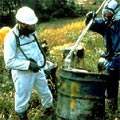|
作者:傑奇•艾倫•朱利安諾 博士
需要多少的犧牲者
才能使我們明白已有太多人死去了
我的朋友啊 答案就在空氣中
答案就在空氣中
-- 鮑伯•迪倫
過去幾週以來,報上一直在討論著恐怖份子要利用農藥噴灑機來散佈生化武器的消息,但是其中很少人提到農藥噴灑機在我們日常生活中的功能。只不過平時使用駕駛這種飛機的不是恐怖份子,而是持有合法執照的使用者,每天將致命的化學農藥灑在我們的土地上以及孩子的身上。
我們不用等待恐怖組織在美國的領土上進行化學戰事,類似的化學戰爭早已進行了將近一世紀。每天有幾十億磅重的化學物質(其中有相當多種類曾在第一和第二次世界大戰中被製成化學武器),被當作殺蟲劑與除草劑使用,灑在動植物泥土上,和世界人類的周遭環境裡。

住在伊利諾州雪頓附近的農夫喬伊•日華特申請了低濃度的除蟲劑,要噴灑黃豆上,以防止西部玉米蟲啃食並在上面產卵。(照片提供 肯•漢蒙德,美國農業部)
在美國,每年有超過60億磅的有毒農藥釋出到生活環境中。根據世界衛生組織 (WHO)的統計,全球每年有超過20萬人死於殺蟲除草劑,這表示每天有547位男女和小孩死於農藥的毒害。此外,每年還有4百萬名的兒童死於受污染的水和其他化學毒物,平均每天有將近1萬1名千個兒童死亡。
根據聯合國兒童基金會的報告,有很多獨立組織證實自1990年以來,已有至少50萬名的伊拉克小孩死於美國禁運令和波斯灣戰爭。
有人認為理所當然,我們應該拯救生命,去向這些威脅和殘忍行為宣戰。
殺蟲劑並不僅使用於農作物上,也會用在教室、辦公室、遊戲場、草坪、操場、浴室、儲藏室、地下室、學校的體育館和安親場所中;廚房和餐廳是最常使用殺蟲劑的地方。殺蟲劑和除草劑被用來減少各種害蟲,包括雜草、老鼠、蟑螂、螞蟻、蒼蠅、跳蚤等等各式昆蟲;目前也有些人在戶外使用這些藥物來殺蜜蜂、螞蟻、齧齒類動物和鴿子。
殺蟲劑和溶劑不似其他的化武劑可以很快的揮發,它們會存留在室內好幾個星期,甚至好幾年。殺蟲劑的殘留物會污染室內環境的表層,並且會殘留在地毯上和灰塵中好幾個月、甚至好幾年。他們也會存留在戶外的泥土中好幾年。另外,一些常在校園中使用的除草劑,甚至可以在泥土中存留1至5年不等。
根據過去20年來的研究發現,殺蟲劑會導不孕症、先天性疾病以及神經系統的失調。
殺蟲劑殘留在農產品和水果上,而且幾乎無法用水洗掉;美國農業部的研究報告指出,在22種小孩常吃的水果中發現108種的農業,另外在8種抽樣的嬰兒食品中發現16種殺蟲劑。
而農藥噴灑機就是這個現象最主要的元凶。不到10%,甚至有人說不到1%的農藥量,是真正噴灑在農作物上,其餘的都飄散在空氣中了,影響好幾哩以外的居民和動植物。
這些化學物質常可以在離施用區好幾英哩遠的地方被發現。美國於1970年代已禁用的DDT,在南極圈冰塊裡、企鵝的細胞組織中以及大部分的種類鯨魚體內中陸續被發現。而距離農藥噴灑區數百英哩外的居民,也可以在吸塵器清潔袋內發現農業用殺蟲劑的殘留物。
地球上的所有生物都緊密的連結在一起。你不可能只影響一樣生物,而不對其他生物產生影響。

數百萬噸的有害物質就這樣被任意丟棄,並對人類、動物和整個生態系產生持續性的威脅。(照片提供 美國環境保護署)
每日噴灑的農藥的效果不只在於除去惱人的蟲害。種馬鈴薯的農夫在即將收成之前,將農藥噴撒在馬鈴薯的葉子上以方便採收的作業。種蘋果的農夫在蘋果上噴灑農藥,讓蘋果可以在樹上停留更久、變得更紅,且不會因風大而掉下來。
據「環境保護團體」估計,每天有110萬名兒童吃下即使洗過,仍含有超過安全標準值的13種有機磷殺蟲劑殘留量的食物;在這一群兒童當中,有16萬6千多位兒童所吃的食物裡的農藥殘留量,是超過美國環保署所規定成人安全劑量的10倍或更多。
最常被發現殘留不合格農藥劑量的作物包括桃子蘋果、玫瑰桃、爆米花和梨子。其中在嬰兒食品中,梨子、桃子和蘋果汁殘留有最高的農藥劑量。
目前的問題比我們所能想像的嚴重多了。我們無法確切知道農藥引起的疾病或死亡的有哪些。一份加州地區的研究報告指出,每20件從小診所被轉送到大醫院的兒童嚴重病例中,就有16件是誤診。事實上,他們都是嚴重的農藥中毒案例。
【文章連載】
■生化武器就在你身邊 (上) (下)
全文與圖片詳見:http://www.ens.lycos.com/ens/sep2001/
2001L-09-30g.html
版權歸屬Environment News Service(ENS),環境信託基金會 (許嘉玲 譯,吳海音、蔡麗伶 審校)
中英對照全文:http://e-info.org.tw/issue/environ/2001/
environ01121801.htm |
|
By Jackie Alan Giuliano, Ph.D.
How many deaths will it take 'till we know
that too many people have died.
The answer, my friend, is blowin' in the wind
The answer is blowin' in the wind.
-- Bob Dylan
There has been much written in the press the last couple of weeks about the threat from terrorists if they commandeered a crop duster to spread biological warfare agents. Yet few writers have mentioned that these planes are used for this purpose every day, but not by terrorists. Instead, they are used by licensed operators who are spraying deadly chemicals on our lands and on our children.
We don't have to wait for chemical warfare to be waged on U.S. soil by terrorists. Such warfare has been underway for over a century. Every day, billions of pounds of deadly chemicals, many of which were used as chemical warfare agents in World War I and II, are applied as pesticides and herbicides to soil, plants, and people around the country and the world.

Near Sheldon, Illinois, grower Joe Zumwalt applies a low-insecticide bait that is targeted against western corn rootworms feeding on and laying eggs in these soybeans. (Photo by Ken Hammond courtesy U.S. Dept. of Agriculture)
The U.S. releases over six billion pounds of toxic chemicals into the environment each year. The World Health Organization (WHO) estimates that more than 200,000 people are killed by pesticide poisons, worldwide every year. That means 547 men, women and children die every day from pesticide poisoning. In addition, four million children die each year from the effects of contaminated water and other toxic hazards. That's nearly 11,000 per day.
UNICEF reports that many independent authorities assert that at least 500,000 Iraqi children under five have died since 1990, in part as a result of the U.S. sanctions and the effects of the Gulf War.
Surely these threats and atrocities are worth waging a war upon to save lives.
Crops aren't the only place pesticides are sprayed. Pesticides are being used in classrooms, offices, playgrounds, lawns, playing fields, locker rooms, bathrooms, storage rooms, basements, school gymnasiums and day care rooms. Kitchens and cafeterias are the areas most frequently treated with pesticides. Pesticides and herbicides are applied to eliminate many kinds of pests, including weeds, mice, cockroaches, ants, flies, lice, ticks, fleas and other insects. Some people spray outdoors to kill bees, wasps, ants, rodents and pigeons.
Pesticide and solvent vapors, unlike most chemical warfare agents that dissipate rapidly, can persist in indoor air for weeks or even years. Pesticide residues can contaminate indoor surfaces, and can remain in carpets and dust for months or years. They can also persist outdoors in soil for years and some weed-killers commonly used at schools can last from one to five years in the soil.
Research over the last 20 years shows that pesticides cause sterility, birth defects, and neurological disorders.
Pesticides stay on fruit and produce and most cannot be washed off with water. In studies done by the U.S. Department of Agriculture, 108 different kinds of pesticides were found on 22 fruits and vegetables commonly eaten by children! Sixteen pesticides were found in eight samples of processed baby food.
Crop dusting aircraft are the worst offenders, possibly contributing to more pesticide poisoning episodes than any other delivery method. Less than 10 percent - some say as little as one percent - of the pesticide gets applied to the crop. The rest becomes airborne and can affect people, animals, and plants many miles
away.
These chemicals are regularly detected in the air thousands of miles from where they were used. DDT, banned in the United States in the 1970s has been found in Antarctic ice, penguin tissues, and in most species of whales! Farm pesticide resides have been found in vacuum cleaner bags of people living in cities many hundreds of miles from farms.
The life systems of the Earth are intimately connected. You cannot affect one without eventually affecting them all.

Millions of tons of hazardous substances have been improperly disposed of and cause a continual threat to human, animal, and ecosystem health. (Photo courtesy U.S. EPA)
Crop dusters spray every day, and not just to end insect infestations. Potato growers apply pesticides from crop dusters to kill foliage on fields they are about to harvest to make it easier to get the potatoes. Apple growers spray a chemical on the apples to keep them on the trees longer so they get redder and don't fall off in the wind.
The Environmental Working Group estimates that every day, 1.1 million children eat food that, even after it is washed, contains an unsafe dose of 13 organophosphate pesticides. Of those children, 106,600 ate food that exceed the EPA's own safe daily dosage level for adults by 10 times or more.
The foods found to most likely contain unsafe pesticide levels are peaches, apples, nectarines, popcorn and pears. Among baby foods, pears, peaches and apple juice had the highest levels.
The problem is much worse than we can even imagine. We have no way of knowing the true extent of the illnesses and deaths that result from toxic pesticide exposure. A study in California reported that 16 out of 20 critically ill children that were transferred to a major medical center from smaller hospitals were wrongly diagnosed. They were actually suffering from acute pesticide poisoning.
http://www.ens.lycos.com/ens/sep2001/
2001L-09-30g.html |
